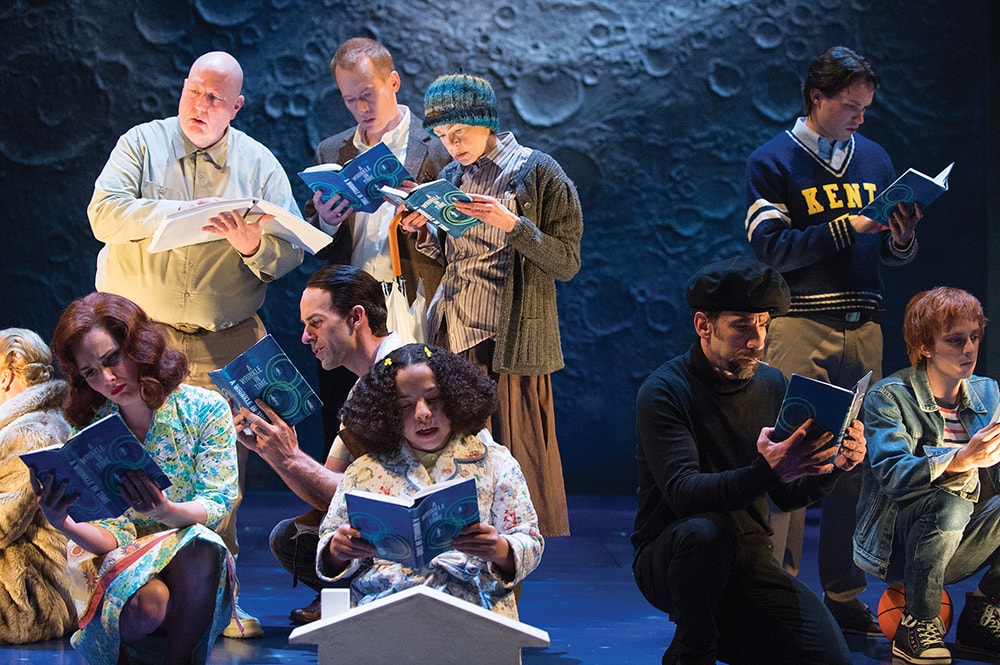The backdrop of the Murry house is pockmarked and crater-filled, like the surface of the moon. Sputniks and satellites dangle from the Angus Bowmer Theatre ceiling. Audiences enter to find the otherworldly scene populated by people busy roaming, writing, exploring, digging into a large toy chest full of goodies. Those who don’t have their noses buried in books (more about this presently) are making notations or passing liquid between beakers. Mrs. Murry, like her lost husband, is also a scientist. Every kid in this play has an inquiring mind. But not everyone has access to a lab. That toy chest becomes an apt centerpiece for Young’s staging. Open it up. What’s inside? What can we use?
Bedsheets are a key prop early in the novel (Mrs. Whatsit swipes a dozen of them to use as ghost costumes to scare away nosy parkers), and they’re absolutely crucial to this Wrinkle—they help make up the transformed, airborne Mrs. Whatsit (who is played in human form by Judith-Marie Bergan). “I was interested in starting from the worlds kids can make in their rooms from stuff that’s at hand, like a bunch of chairs, or things off the bed,” Young says. “I wanted to start from a place where childlike imagination was really at play.”
Homage to the source is paid throughout; every single character appears studying a copy of A Wrinkle in Time at some point. “The passionate reactions and memories of the readers became the starting point for this adaptation,” Young writes in her program note. Even with the show open, cast members are continuously reading the book in their spare time, using Wrinkle more as a touchstone than as a security blanket. “You weren’t required to read it,” says Sara Bruner, who plays Charles Wallace. “But you would have to be a real jerk not to.”

L’Engle describes the transformation of Mrs. Whatsit into a creature of majestic beauty with a marble white belly and a magnificently modeled back—she takes all three children up into the heavens to look over the universe. If Wrinkle is ever filmed again, the sequence that will almost certainly be manifested via CGI effects. Not here. “Yes, there’s this magical, fantastical thing, and we see what it’s made of,” Young says. “It’s like the antithesis of a filmic solution, but we’re showing the delight in how it’s created. And there’s magic in that, too.”
Meg Murry is introduced, L’Engle lovers will recall, wrestling down insomnia on a crazy, wind-swept evening. In the stage version, ensemble members roll in the bed and spin it, tossing Meg about. In the role, Alejandra Escalante sports a symmetrical curtain of frizzed-out hair and a mouthful of braces. None of Alex Jaeger’s costumes flatter this square peg, yet Meg is luminous as she leads this epic expedition. (In a fitting bit of casting synchronicity, Escalante’s other OSF role this summer is Miranda in Tony Taccone’s production of The Tempest—Meg and Miranda, explorers of brave new worlds.)
Informing Bruner’s portrayal of Meg’s wise and remarkable five-year-old brother is the theory that Charles Wallace might fall on the autism spectrum (a genius, socially awkward child with powers of empathy who doesn’t speak until he is four). During the section on Camazotz, when Charles Wallace is possessed by the malevolent force of IT, Bruner is replaced by a large ventriloquist’s doll designed by Lynn Jeffries.
And there’s another girl on this journey who looks to be about Meg’s age: a bookish young lady called “Science Girl” (played by Jada Rae Perry) who is working on a project called “How to Tesser.” Created by Young as a type of framing device, Science Girl pays homage to dreamers and creative minds of all ages, and particularly young women who—in 1962, at least— were not routinely encouraged to get their hands dirty with things like equations and test tubes.
It gives away nothing to say that Science Girl’s “How to Tesser” project takes a prize. As previously noted, only a fool bets against a person with the moxie to envision, create and visit other worlds.
Evan Henerson is a theatre writer and critic based in Los Angeles.


